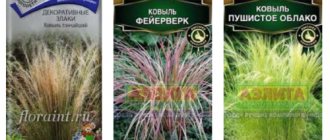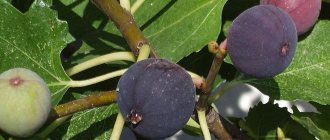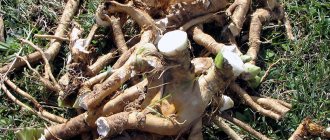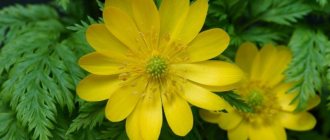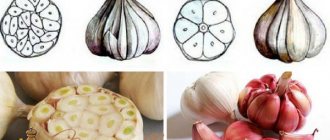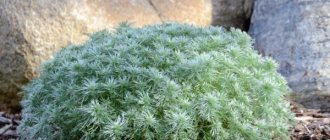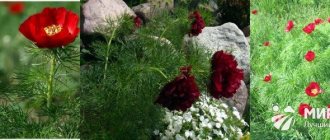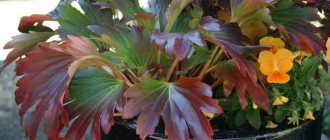Not everyone can grow parsley. Many gardeners complain that the plant comes out with small leaves, is tasteless, or does not sprout at all. Such problems occur regularly.
We'll tell you how to grow parsley in open ground, and talk about seedling and non-seedling methods. We will give information about watering, fertilizing, harvesting and tell you how to avoid mistakes.
What types of parsley are there?
Parsley is a biennial plant, meaning its seeds can only be obtained in the second year after sowing. This is a cold-resistant crop; with little shelter, it can produce crops even after frost. For successful cultivation, it is necessary to follow the watering regime and apply fertilizers correctly.
There are two types of parsley: leaf or curly and root. Often, novice gardeners are not aware of these features and can expect abundant greenery from root varieties.
You can understand the difference between leaf and root parsley using the table.
| Leaf parsley | Root parsley |
| The ground part is eaten | The underground part is used for food |
| Large rosette, about 80 leaves | Small rosette, no more than 40 leaves |
| Root small, many lateral shoots, inedible | The root is massive, edible, the lateral shoots are insignificant. |
| The leaf is soft, the taste is normal | The leaves are hard and have a pungent taste. |
There are also differences in agricultural technology. For example, both types need nutrients, but root parsley prefers phosphorus and potassium, while leaf parsley requires nitrogen in recommended dosages.
The leaf of curly parsley can be cut 2-3 times per season, but this should not be done when cultivating the root type of plant.
Care after planting in open ground
When the first seedlings emerge, it is necessary to loosen the soil and thin out the seedlings. The first thinning is performed when there are 2-3 leaves. The distance between bushes should be more than 2 cm.
The second thinning must be performed when there are 5-6 leaves. Leave no more than 6 cm between plants.
Loosening the soil and removing weeds must be done at least 4 times
During the season it is necessary to fertilize 2 times and be sure to loosen at least 4 times. The first fertilizing is applied to the soil when the seedlings have 2-3 leaves. Fertilizers rich in nitrogen are best suited for this purpose.
The stems should be cut as close to the ground as possible. It is not recommended to cut a large number of leaves from a bush at once in one day. You need to cut off 1/3 of the bush to give the bush time to recover. If you do not plan to collect seeds, then the stem with inflorescences must be removed, since new leaves will not grow.
A prerequisite for growing for a good harvest is regular watering, removing weeds and loosening the soil. Watering must be done in the evening. Loosening is necessary to provide oxygen access to the roots of the plant. If there is a need to obtain a harvest before late autumn, it is recommended to sow parsley twice a month.
The following varieties are recommended for planting in spring:
- Leaf parsley " Ordinary ". Refers to early ripening varieties. Ripens in 70 days. The taste is spicy, the leaves are dissected, the rosette is powerful. Only the leaves are edible.
- " Breeze " - leafy. The ripening period is 80 days. The taste is delicate, retains freshness and taste for a long time after cutting.
- " Astra " is a curly variety. Ripens in 65 days. After cutting, the bush quickly recovers and grows back.
- “ Urozhaynaya ” is a variety of root greens that has a pointed root. Maturation period 130 days,
- " Festival " - leaf parsley. Ripening time is 56-65 days. The leaves are dark green in color, fragrant, and heavily lobed. After cutting it grows back well.
Principles for choosing a variety
Any ratings and selections of “best varieties” that can be found on the Internet and in print publications are very arbitrary. Gardeners have their own requirements for plants: some care about yield, others prefer ripening time and disease resistance. Therefore, you can rely on ratings, especially if new varieties are presented there, but you cannot blindly trust them.
Before purchasing a specific variety, you need to check the following points:
- They are trying to sell you a leaf or bush variety.
- Is it zoned for your region?
- What are the ripening times and soil requirements?
- Is the variety resistant to diseases?
- For what purposes is it usually grown?
There are many varieties on the market that have not been tested in Russia and therefore are not included in the State Register. You can buy them, but the results can be unpredictable. For example, parsley may not withstand your climatic conditions and die or produce less than the declared yield.
Parsley can be early-ripening, mid-ripening and late-ripening - it takes 60, 65-70, 70-80 days to ripen, respectively. The names of some leaf varieties that can be grown in most of Russia can be found in the table.
| Ripening period | Variety names |
| Early | Astra, Gloria |
| Average | Common leaf, Esmeralda, Breeze, Italian giant* |
| Late | Bogatyr |
*The variety is shade-tolerant, suitable for cultivation in greenhouses and greenhouses, including film-type ones.
To choose the best option for yourself, plant and grow several varieties, then compare your impressions of them.
Fight against enemies
If you know what diseases and pests can affect root parsley, then it will be much easier for you to prevent their development and eliminate them at an early stage of damage. Most often, parsley is affected by the following diseases:
- White rot . This disease is concentrated on the surface of the plant. If the lesion grows, sclerotia of the fungus are formed. As a result, the plant tissue becomes soft and the roots rot.
- Downy mildew . This disease is concentrated on the leaves. First, chlorotic inclusions form on them, and then they turn into yellow spots.
- Rust . Parsley produces a rusty tint. This disease forms in early summer. If you do not provide assistance to the affected crop in time, the leaves and stem turn brown.
- White spotting . This disease makes itself felt by the damage to the lower leaves, stems and cuttings. You will find pale spots with a yellowish tint on them. At first they are small in size, but over time the spot grows and can completely affect the entire leaf. Numerous pycnidia are formed on damaged tissues.
- Cercospora leaf blight . The disease affects leaves, stems and umbels. The disease manifests itself in the form of spots that have an angular, rounded shape. The spots are yellow or dirty brown in color.
- Carrot psyllid . This insect has a light green color. Its larvae are greenish-yellow in color. Adults and larvae use plant sap for their nutrition.
- Carrot flour . Plants affected by this insect are stunted in growth, their leaves have a reddish-purple color. As a result, the foliage then turns yellow and falls off.
- Stem nematode . It most often attacks onions and garlic, but today many gardeners have begun to notice that the insect is not averse to eating root parsley. Adults and larvae use plant sap for their nutrition.
- Melon aphid . This pest is located below on the leaves, flowers and stem. Insects feed on parsley juice. The affected crop begins to shrink, turn yellow and dry out.
In the video - root parsley:
Growing root parsley is a simple process. It is fashionable to produce it in two ways: seedlings or seeds. It is worth choosing the appropriate option taking into account the climatic characteristics of your region. Caring for this crop is also simple; it is important to ensure timely watering, loosening and pest control.
Possible diseases of parsley root
During the growing season, symptoms of diseases can be seen on the leaves. The most common:
- white spotting;
- rust;
- peronosporosis;
- white rot;
- cercospora blight
| Symptoms | Disease |
| Yellow, chlorotic spots on leaves | Downy mildew |
| Light spots on the bottom of the cuttings and leaves | White spot |
| Yellow or brown spots on leaves that are round or striped | Cercospora |
| Rusty spots appear at the beginning of summer | Rust |
| White coating on the top of the plant, the root crop is rotting | White rot |
The causes of the disease are excessive watering, dense planting, lack of light, and failure to observe crop rotation.
Pests
Root parsley is attacked by melon aphids and carrot flies. The greatest damage is caused by carrot psyllid larvae. They parasitize the upper part of the root. For prevention, the bed is sprinkled with ash mixed with tobacco dust in a 1:1 ratio.
When aphids appear, wash parsley leaves with a soap-ash solution or infusion of onion peels. The treatment is repeated every 3 days. To repel carrot flies, plants are sprayed with water and kerosene is added to it. Pour 1 tbsp into 1 liter. l means.
Preparing the beds
Leaf and root parsley are extremely demanding both in terms of soil type and its fertility. On heavy, clayey soils that tend to retain water on the surface, the plant will develop poorly. Root parsley does not produce a harvest at all - its roots, breaking through the clay, become thinner, bent, and then acquire a dirty brown color. Leaf parsley reacts in such conditions by reducing the volume of the tops, poor growth, and its leaves become pale green.
To successfully grow parsley, the soil must be loose, ideally sandy loam or loamy soil. Choose a sunny place, protected from cold northern winds, without stagnant melt and rain water. The bed is prepared in the place where potatoes or tomatoes were previously grown: here the parsley will hurt less and grow better.
If the soil is clayey and not fertile, then add the following substances per square meter:
- humus - half a bucket;
- sand - 2 kg;
- superphosphate - 1 tablespoon;
- potassium sulfate - 1 tablespoon;
- half a liter jar of wood ash.
You can apply urea from nitrogen fertilizers, but about 2 weeks before sowing parsley.
The bed is dug up, the roots of perennial weeds, debris, and large stones are removed. It is desirable that the soil be loose, so the lumps are carefully broken up. The surface of the bed is leveled and furrows are cut at a distance of 10-12 cm from each other and a depth of 1 cm. The day before sowing, the furrows are shed with a weak solution of potassium permanganate at the rate of 3 l/m2.
It is advisable to make the bed several weeks before sowing so that the soil has time to settle. Otherwise, it will settle along with the seeds and they will not be able to sprout, or seedlings will appear much later.
Choosing a place to plant parsley in the garden
Growing parsley is also easy because it is not picky about soil. However, it will feel best on the ground with a light, loose structure. The most suitable option for planting parsley is light loamy or sandy loam soil with neutral acidity.
Please note which places in the garden should be avoided:
- too wet;
- too dry;
- in high groundwater levels;
- lowlands where moisture accumulates.
Note! Parsley is a biennial plant, so choose a location keeping in mind that the bed will be occupied for 2 years.
If the soil at your summer cottage is poor in nutrients, it is recommended to fertilize . organic fertilizers in the fall (or spring at least a couple of weeks in advance) , the application rate is 1 bucket per square meter, if the soil is moderately poor, and if it is very poor, then 2 buckets per sq.m. .
In addition to organic matter, it is useful to apply mineral fertilizer , for example, Nitroammofoska, it contains nitrogen, potassium and phosphorus (apply according to the instructions on the package). If you have not applied nitroammophoska, then in the spring it is advisable to apply nitrogen fertilizer, for example, urea, ammonium nitrate.
When preparing the bed, be sure to remove the weeds along with the roots!
Choosing a place for a garden bed based on the principles of crop rotation
An excellent guide when choosing a bed for sowing is the principles of crop rotation. What is the best time to plant this crop? Good predecessors for parsley are cucumbers, cabbage, onions, tomatoes, potatoes, zucchini, and squash. That is, it is better to sow seeds in a garden bed where one of the listed crops was grown in the previous season.
After what can you not plant greens? It is not recommended to sow the crop after growing umbrella crops (that is, parsley, carrots, dill, coriander, fennel, celery).
Do you know which neighbors are good for parsley? You can plant the crop next to dill, carrots, cilantro, tomatoes, cucumbers, and legumes.
Proper sowing of parsley
If parsley is grown as a herb, it can be planted in several stages. The first begins in mid-April, in the southern regions in mid-late March. The second stage begins in the first half of June, the third in October-November: to get greens in early spring.
Regardless of the sowing time, you need to properly prepare the planting material. The protective shell of parsley seeds contains essential oils that prevent germination and significantly delay the emergence of seedlings. Therefore, they are pre-processed:
- Place in a colander and pour over water heated to 50-60 °C.
- Soak for 12 hours in warm water.
- Dry it.
There is an express method for preparing parsley seeds for sowing, but you need to use it carefully. The seeds are placed in a specially sewn gauze bag and dipped in vodka for exactly 10 minutes; do not overexpose. Then remove, wash in running water and dry.
After such preparation, the seeds will sprout quickly and quickly.
When is the best time to sow parsley: in autumn or spring?
A question that interests gardeners who are starting to grow parsley for the first time is when to put seeds into the ground in order to get strong shoots that develop quickly and produce a bountiful harvest? There are opinions that autumn planting allows you to grow strong plants, but experienced gardeners recommend planting in the spring.
Planting parsley in spring has the following advantages:
See also
How to grow parsley from seeds on a windowsill in winter and care for itRead
- there is no need to use the seedling method to obtain an early harvest;
- planting can be done immediately after the snow melts;
- young plants grow and develop rapidly under the warm spring sun;
- spring seedlings are less likely to get sick;
- The plants are powerful and do not require frequent feeding.
Another advantage of spring planting is that even if some seeds do not sprout, it is never too late to replant. Before the warm summer days, more than one generation of young plants will have time to sprout.
A prerequisite for spring planting is to carry it out only after the soil surface has warmed up to five degrees. If the soil is cold and too wet, there is a risk of losing planting material - the seeds will begin to rot and will not sprout.
Ways to grow parsley
Parsley can be grown in open and closed ground, without seedlings and seedlings. Let's talk about the last two in more detail.
Planting by seedling method
Russia has different climatic conditions and summers are not long everywhere. I want to eat greens fresh every year. In regions with short summers, you can grow parsley seedlings and get the harvest much earlier, and harvest it not once, but twice during the season.
When growing a plant using the seedling method, you need to perform the following steps:
- Prepare cassettes with 4x4 cm cells - wash them with a solution of potassium permanganate and dry.
- Prepare the soil: peat, humus and garden soil in a ratio of 1:1:2.
- Pour the soil into the cassette so that there is 1.5-2 cm left to the top.
- Place 2-3 prepared parsley seeds in each cell.
- Sprinkle with loose mixture, 0.5-1 cm thick.
- Water, preferably using a spray bottle or pipette, so as not to wash out the seeds.
- Cover the containers with polyethylene; it is more convenient to use cling film.
Care involves regular ventilation, watering and protection from direct sunlight. If everything is done correctly, shoots will appear in a month. As soon as 2 true (not cotyledon!) leaves appear, the plants are inspected and the excess ones are cut off at the root, leaving the strongest sprout.
At the beginning of May, seedlings can be planted in open ground. By this time there should be 3-4 full leaves.
Planting without seedlings
You can sow parsley seeds directly into open ground, bypassing the seedling stage. In this case, a week before the planned work, the bed is covered with plastic film to warm it up. Then sow parsley in the grooves in a thin line or with an interval of 7-15 cm between seeds (the distance depends on the variety and size of the rosette). The sowing depth is 0.5-1 cm. The furrows are sprinkled with loose, fertile soil and carefully watered from a watering can with a fine mesh.
If the first planting option was chosen, the parsley needs to be thinned out. The first time this is done after the appearance of two leaves, leaving a distance of 3 cm between the plants. The second time, after about 2 weeks, remove the excess bushes, leaving a distance of 10-15 cm between them. When planting in rows, it is better to leave the parsley in a checkerboard pattern, so each plant will get maximum moisture, nutrients and sunlight.
According to the standards, per 1 m2 of area there should be 30 bushes of leaf parsley and no more than 20 root varieties. Then the plants develop normally.
How quickly does parsley sprout?
The germination rate of parsley depends on a number of factors. These include the following several indicators:
- climate in the region;
- seed quality and treatment before sowing;
- care after landing;
- watering quality.
The colder the climate in the region, the longer the germination time takes.
You can sow seeds when the soil temperature rises to +4 +5 degrees. At the same time, at night the temperature can drop to -7 -9 degrees. But for active growth you need a temperature of +18 and above. Therefore, the first shoots appear no earlier than after 3-4 weeks. This is due to inhibitors and essential oils that are poorly permeable to moisture. To speed up the germination process, it is necessary to carry out stratification:
- soak in hot water about 50-60 degrees, it is important not boiling water;
- hold in a weak solution of magnesium permanganate;
- Sprout in a dark, cool and humid place.
Thus, germinated seeds sprout within 7-10 days. If planted in a greenhouse, then at temperatures above +15, sprouts appear within 5 days.
Early ripening parsley can be harvested within 1.5 months after planting. Mid-season varieties grow 20 days longer. This way you can plant several crops and have fresh herbs on the table all year round.
Parsley care
Parsley is less dependent on ambient temperature than other crops. The most favorable temperature for it is in the range from 12 to 20 °C, but the plant develops well on hotter days. Parsley can withstand frosts down to -9 °C without damage, but the plant should not be weakened at this point.
Water supply is important for parsley. Some gardeners believe that the more there is, the better. In fact, this is not true: abundant watering is needed only during prolonged drought; in other cases, moderate watering once a week or two is sufficient. In summer, it is better to water parsley in the evening, and in spring and autumn in the first half of the day, when the air warms up.
Plant nutrition
Without regular feeding, both leaf and root parsley stop growing. Only the needs of these plants are different: it is more important for leafy varieties to receive nitrogen, it contributes to the formation of green mass. Root species, on the contrary, need less nitrogen; emphasis on phosphorus and potassium is important.
For parsley, use the following feeding scheme:
- the first after the formation of two true leaves;
- the second as soon as six leaves appear;
- the third after cutting the green mass.
Next, parsley is fertilized after each harvest, this helps the plant recover faster and grow green again.
Fertilizers, dosage and features of feeding leaf and root parsley can be seen in the table
| Top dressing | Leaf parsley | Root parsley |
| 1. | Ammonium nitrate 10 g/m2, superphosphate 5 g/m2 | Potassium salt and superphosphate 10 g/m2, ammonium nitrate 15 g/m2 |
| 2 | Urea 5-6 g/m2 | In July, urea 5 g/m2 |
| 3 | Ammonium nitrate or urea according to standards. | In August, potassium salt 7 g/10 l* |
*The last feeding of root parsley should be a month before harvesting.
It is important not to exceed the dosage of urea and ammonium nitrate - parsley can accumulate nitrogenous compounds, converting them into nitrates harmful to humans.
If for some reason it is impossible to use chemical fertilizers, you can prepare a solution of chicken manure and water the beds with it. It is an excellent source of nitrogen. Another option is nettle infusion prepared according to the following recipe:
- take nettle tops, chop;
- place in a barrel, add water so that it lightly covers the mass;
- add a handful of baker's yeast;
- keep in the sun for 2 weeks;
- strain before use.
Instead of nettles, you can use any green material - mown grass, weeds from the garden, etc. The main thing is that there are no seeds. Instead of barrels, any large-volume container will do.
The resulting dark slurry is diluted with water in a ratio of 1:10. Feed parsley twice a month.
Disease Control
If you follow the rules of agricultural technology, well-established watering and timely fertilizing, parsley rarely gets sick. However, diseases cannot be excluded:
- Powdery mildew - first the leaves, starting from the lower ones, become covered with a white coating, then darken. Treatment is carried out with the drug "Quadris" or any other fungicide.
- Stolbur - first the edge of the leaf turns red, then the entire leaf. The affected plant dries out and dies. The disease appears more often at the end of August and cannot be treated. Preventive measures include seed dressing and foliar feeding with a 0.04% boric acid solution.
- Alternaria blight is a black, rotting lesion on the roots and lower part of the stem. There is no treatment, prevention consists of moderate watering.
Sometimes white spots appear on parsley leaves, which eventually turn brown. This is how septoria or white spot appears. The disease can be treated by using any fungicide.
Parsley diseases are easier to prevent than to treat. To do this, you need to keep the beds clean, do not over-moisten the soil, and carry out preventive treatment in regions with a high risk of developing certain diseases.
Pest Control
There are no insects that parasitize exclusively on parsley. However, these pests can migrate from other crops and cause significant damage by eating leaves or sucking sap. Therefore, you need to fight them in advance.
Most often, parsley is attacked by the following pests:
- Carrot fly - destroyed by drugs "Ariva", "Karate". There are varieties resistant to this insect.
- Stem nematode - causes deformation and damage to stems. They are destroyed with chemicals, for example, “BI-58”. The best prevention is moderate watering and liming of the soil.
- Aphids - suck the juices, which leads to the death of the plant. The range of means used is wide, from chemical to folk.
To prevent pest invasions, it is important to observe crop rotation, weed control, and adherence to other agrotechnical standards.
Chemical treatment must be stopped 30 days before harvest!
The difference in planting in spring and before winter: what to choose and when?
The main differences lie in the timing of planting, the choice of suitable varieties , and the purpose of cultivation. In order to regularly receive fresh greens throughout the warm season, planting is carried out in the spring, starting from the end of April. You can also sow parsley, most often leaf parsley, using a conveyor type - every 2 or 3 weeks.
Sowing before winter is cultivated in order to obtain early greenery. Parsley is not afraid of temperature changes or frosts. It is important to sow the seeds in late autumn in slightly frozen soil so that they do not swell and germinate. After natural hardening by cold, strong green shoots will appear in early spring.
Harvesting
Parsley grows slower than other greens - the first cutting is carried out 60-70 days after emergence. Many gardeners do not adhere to this period and take parsley from the garden as needed. You can do this, but then you will end up with less collected green mass.
After the first harvest, nitrogen fertilizers are applied, as a result the next cut will be faster - in 40-45 days. In most regions of Russia, this is where the harvest ends, but in southern latitudes, parsley is left until winter, covered with film, and in the spring the regrown leaves are cut off for the third time.
Root parsley is harvested before the onset of prolonged cold weather. Depending on the region, this is the end of September - mid-November. In this case, its taste qualities will be fully demonstrated. If the root vegetables have sprouted, you can plant them in containers, place them on the windowsill and get greenery in early spring. It is not suitable for salads, but after heat treatment it will be suitable for food.
Types and varieties of parsley
There are two main varieties of parsley – root and leaf. There are a huge number of varieties of each type. All of them differ in the timing of sowing and harvesting, the size of the roots and the abundance of greenery.
Parsley root
In this type of parsley, the root is of primary importance; all the plant’s forces are spent on the development of this particular part of the plant. In this case, greens can also be used, the taste does not suffer. The root, as a rule, grows fleshy and cylindrical in shape. It is good to use for further preparation of dry additives in dishes and medicinal tinctures.
Berlin
Belongs to late-ripening varieties. Harvest occurs after 150-180 days. The cream root, 4 cm in diameter, has a cone shape with a sharp tip. The length can reach 20 cm or more. Gardeners describe the pulp as incredibly tender and tasty. The leaf rosette is spreading with long stems and dark greenery. Harvesting can take place from June to September, depending on climatic conditions and planting dates. The roots perfectly complement salads and pickles.
Sugar
It is one of the most delicious varieties. From the name it is clear that the root has a sweet taste, but not cloying. The yellow core and white-gray peel forms a conical root crop no more than 30 cm long. A distinctive feature is the high content of vitamin C, carotene, and calcium salts. Refers to early ripening varieties, harvesting can be done already 76-100 days from sowing. Spreading leaves in the amount of 20-40 pieces form a powerful rosette. Under favorable growing conditions, it produces a bountiful harvest of up to 6 kg per 1 sq. m. m landing.
Bordovikskaya
Great for adding to soups, borscht and cabbage soup. The leaves of the plant are a rich emerald color, with a matte texture underneath. Distinctive features:
- special aroma of white cylindrical root;
- good keeping quality;
- resistance to pests and diseases.
The root of Bordovician parsley reaches 120-160 grams, the juicy leaves are successfully used as food.
Mid-season Harvest
Ripens 130-140 days after sowing. The rosette is semi-spreading with 20-25 leaves. From one square meter of soil you can harvest up to 7 kg of crop. Loves light, but will give good results in semi-shaded areas.
Leaf parsley
This parsley is ideal for greens in salads. Shoot growth is fast and abundant. Different varieties have their own unique aroma and taste. It is divided into two types - smooth and curly. The latter also has decorative qualities.
This type of greenery has smooth leaves without curls, but with characteristic ragged edges. The rosettes are fluffy with many dark green shoots. One bush can grow up to 100 leaves. The roots of such varieties are not suitable for human consumption.
Harvest common
Fragrant greens with excellent yield. The early variety becomes ripe 70 days after emergence. The rosette is characterized by the presence of up to 100 dark green leaves. The root vegetable is not eaten.
Green crystal
High-yielding parsley for universal use. Greenery grows intensively and abundantly. Large leaves grow back after cutting in a short time. This variety is good for any use, especially for freezing. Suitable for canning and drying for the winter.
Festival
From the moment of the first shoots to ripeness it takes 55-60 days. The strong bush has from 30 to 60 dark green leaves. The variety is resistant to frost. The optimal height of the bunch for cutting is 10-14 cm, if the greens are needed for fresh consumption. For drying, it is better to start collecting at the moment of bud formation.
Natalka
Ripens in 55-60 days and gives a high yield. Powerful green bush. The leaves are large, emerald, juicy. It is highly aromatic and contains a complex of essential oils, vitamins and mineral salts. Valued for its high yield of leaves, resistance to disease and cold, and rapid growth after cutting. Recommended for consumption in any form: fresh, dried and frozen. In the kitchen it is used as a seasoning for pickles and first courses.
Curly varieties of leaf parsley
Curly parsley is not only an excellent taste, but also an opportunity to decorate a dish. The aroma is persistent and well expressed. The advantage is the rapid growth of new shoots after cutting the crop. The freshness of collected greens lasts up to 7 days.
Esmeralda
From one plant you can collect 50 grams of greens. There are 30-40 leaves in a bunch. After cutting, the plant quickly restores its green mass. Up to 1-1.5 kg of harvest can be obtained from a square meter of land.
Moskrause
The German Guest is known for its beautiful curled leaves. Greens are good both dry and fresh. The variety is early ripening, which is why gardeners love it.
Gloria
Early ripening and high-yielding variety. It is suitable for growing both in a greenhouse and in open ground. The bush grows low with large leaves. Perfectly tolerates long-distance travel and storage in the refrigerator.
Bravo
The variety was bred by Russian breeders. The plant has long vertical petioles. The leaves are very curly and brightly colored. Characterized by a strong aroma.
Bogatyr
Belongs to a late-ripening variety. It has the best taste when fresh. The popularity of this parsley is due to its high yield. After cutting off the first leaves, new bunches quickly grow.
Slavic
The peculiarity of this parsley is its ability to tolerate low temperatures and long-term lack of watering. The bush is quite compact, the stems are low and spreading, the leaves are curled and have a rich emerald color. The bush can be pruned several times in one season. Gardeners love Slavic parsley because of its ability to maintain freshness for a long time after cutting.
Common Mistakes
Many gardeners are so disappointed in parsley that they despair and don’t plant it anymore. Let's look at some problems and their causes.
- Parsley takes a long time or does not sprout smoothly. The reason is insufficient preparation of seeds or their expiration date (more than three years).
- Leafy varieties practically do not grow, even by summer they do not reach a height of 5 cm. The reason is a nitrogen deficiency - add a solution of chicken manure or urea according to the norms.
- Leaves turn red or yellow - disease damage, preventive treatment is needed.
Sometimes parsley is grown in continuous rows without thinning. This can be done, but the leaf height will be lower, plus regular and more frequent fertilizing with nitrogen fertilizers will be required. As a result, this may affect the health safety of greens.
Many problems can be avoided if you plant marigolds around the perimeter of the garden bed. They will repel insect pests and carriers of certain diseases.


